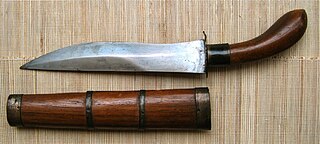This is a list of types of swords.

The kampilan is a type of single-edged sword, traditionally used by various ethnic groups in the Philippine archipelago. It has a distinct profile, with the tapered blade being much broader and thinner at the point than at its base, sometimes with a protruding spikelet along the flat side of the tip. The design of the pommel varies between ethnic groups, but it usually depicts either a buaya (crocodile), a bakunawa, a kalaw (hornbill), or a kakatua (cockatoo)..

The talwar, also spelled talwaar and tulwar, is a type of curved sword or sabre from the Indian subcontinent.

Dha is the Burmese word for "knife" and "sword" similar term to daab or darb in Thai language for a single edge sword. The term dha is conventionally used to refer to a wide variety of knives and swords used by many people across Mainland Southeast Asia, especially present-day Myanmar (Burma), Thailand, Laos, Cambodia, and Vietnam.

Mandau is the traditional weapon of the Dayak people of Borneo. It is also known as Parang Ilang among the Bidayuh, Iban and Penan people, Malat by the Kayan people or Baieng by the Kenyah people or Bandau by Lun Bawang or Pelepet/Felepet by Lundayeh. Mandau is mostly ceremonial. However, a less elaborate version called Ambang is used as an everyday practical tool.

The gunong is a knife from Mindanao and the Visayas islands of the Philippines. In ancient past, it was called bunong by the Tagalog people. It is essentially a diminutive form of the larger kalis or kris. The gunong serves both as a utility knife and as a thrusting weapon used for close quarter fighting—usually as a last defense. It is most often associated with the Maranao, among whom the gunong was traditionally carried by both sexes, although it exists in other cultures throughout Mindanao and the Visayas. The weapon is generally tucked into the back of a waist sash.

A claymore is either the Scottish variant of the late medieval two-handed sword or the Scottish variant of the basket-hilted sword. The former is characterised as having a cross hilt of forward-sloping quillons with quatrefoil terminations and was in use from the 15th to 17th centuries.

Niabor is a curved sword from Borneo, a characteristic weapon of the Sea-Dayaks.

Jimpul is a traditional weapon of the Sea Dayak and Kenyah people from Borneo. It is often thought that the Parang Jimpul may be considered as a hybrid between the Mandau and Langgai Tinggang. The Parang Jimpul is an intermediary form between the Mandau and the Langgai Tinggang dating from c. 1870-c. 1885.

The Pandat is the war sword of the Dayak people of northwest Borneo and is never used as a tool. On October 18, 2016, this weapon was featured in season 3 episode 9 of the American bladesmithing competition series Forged in Fire.

Parang Nabur is a sword that originates from Banjarmasin, South Kalimantan, Indonesia. Most of these swords were made during the Banjarmasin Sultanate period in the 19th century.

Balato is a sword that originates from Nias, an island off the west coast of North Sumatra, Indonesia.

Pisau raut is a whittling knife that is commonly as a tool to prepare the rattan and other fine carving found throughout the entire Malay archipelago. It is well known as an accompanying knife placed in the same sheath with the mandau, a traditional weapon of the Dayak people.
Gayang is a common traditional Filipino ethnic Moro weapon in Sulu archipelago. It is a double-edged sword about 24–48 in (61–122 cm) in length with a typical hook hilt grip to prevent slipping. The sword was believed to be from Borneo and was a Philippines' version of Mandau, a traditional sword of the Dayaks of Borneo.

A Keris Bahari is a long version of a kris dagger mainly used in Sumatra. It is also called Keris panjang. Keris bahari is dubbed by European people as "Sumatran rapier kris" or "execution kris".

The Belida sword is a weapon from Flores, Indonesia.

The Pakayun or Parapat or Pelepet / Felepet is a sword very characteristic of the Murut people originating from Borneo.

The Dohong is a dagger or short war sword from Borneo. The name is used figuratively to imply bravery. In other parts of Borneo, it is simply referred to as Mandau. The Dohong is considered an ancient Dayak sword that was used long before the Mandau was introduced. It is believed to be the oldest weapon of the Dayak people. According to folklore, the first people who owns the Dohong are the forefathers of Dayak people, namely Raja Sangen, Raja Sangiang, and Raja Bunu.

Tumbok Lada or Tumbuk Lada is a traditional slightly curved dagger that originates in the eastern coast of Sumatra, Indonesia but also found in the western coast of Malay Peninsula, Malaysia.

The Buko, also called Buku or Parang Buko is a cleaver (parang) that originates from Borneo. This parang is used by the native Bidayuh people. While the Buko is also used by the Malays chiefly for carpentering purposes.





















